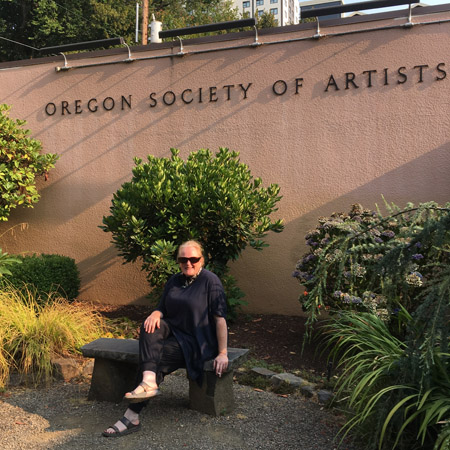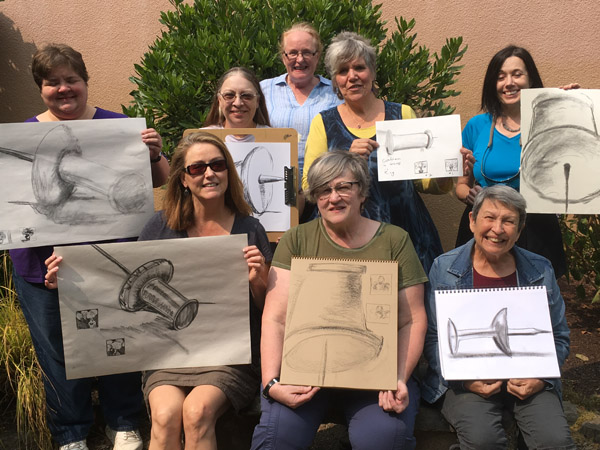As I have mentioned (lol) I spent last Saturday-Monday taking a drawing workshop with Ruth Buchanan at the Oregon Society of Artists. Recently the Artists Network published a GREAT article on this same topic: 10 Approaches to Drawing. My post will focus on my own development; please see the article for the details of the techniques described. Additionally, Ruth published two great articles in The Artist (UK) magazine on drawing horses that I recommend.)

The title of this post is one of the first things Ruth asked the class. I’ll see if I can answer it.
(Note: This is a “PG” post; we did “life drawing” on Monday.)
Saturday – Maquette and Keyline
After some initial introduction, Ruth started us off with the “maquette” technique (some may recognize it from anime or traditional drawing books.)

As you can see, the technique starts off with some basic structure and works outward from there. I have done this method many times, but I liked that Ruth allowed us to use it without lecturing unduly on correct proportion.
Because I am “that person” I worked on some other drawings using this technique in the slow times.
Next we moved to the key line approach. I have heard of this method, but I have never understood it. I understand it more now, but I clearly have some work to do (as you’ll see by my attempts).
I also took advantage of the time to work on my sketchbook. I think a few of these might become something.
Sunday – I can draw without looking at the paper
Sunday dawned and I was excited to get back.
We started out with a surprisingly difficult exercise: drawing the negative. This is something I have heard people talk about. I thought it would be easy. Ah… no.
This exercise made my head hurt. I kept wanting to cheat and draw the interior. And these were just tables!
From here we had a talk on composition, the six-lights approach, and artistic “intention” before moving on to (what I know to be) Ruth’s trademarked trick: impossibly short timed exercises.
From there we worked on our catch-phrase activity of the day: contour drawing a pineapple.
Finally we took all this and drew a very small object VERY large. The instructions were to fill up the paper.

And then we painted some very big flowers very small (these appear much larger than they are.)
The thumbtack was the exercise I asked the class to pose with for the newsletter article I will have to write to thank the Watercolor Society of Oregon for sponsoring Ruth coming over again!

In between all this, I worked on my sketchbook some more, mainly developing an idea for a painting.
Monday – FASTER!
As with all true performances, Monday was the crescendo. We had a model come in during the morning so we could practice these techniques and more. The lovely Gaby did a fabulous job, but if you can tell it’s her from these drawings, I would be SHOCKED!
Ruth started us out with another series of timed poses.
At this point, I lost a little bit of focus on what Ruth was trying to teach us with the effort of just keeping up. The next set of drawings are when we were working on… something (possibly looking at negative space and adding emphasis.)
Then tricky Ruth made us STOP drawing the model and draw around her. In the second, we were told we could draw everything BUT the model.
I can see either one as a painting, but my head still hurts.
Not to let us rest on our laurels, Ruth then had the model “walk through” poses so we could look for movement and line.
The first drawing here is my favorite of the day. I like the way I caught her foot and the hinted-at hands. Ruth pointed out that this method could be used on horses. A light bulb went out for me!
Next, Ruth had us draw tones, not lines.
Finally, devious Ruth made us select five tools and called out to us to change them at timed intervals. And then she made us change paintings with each other!

Final exercise, not all my work.
Ruth finished the day with a wrap up; I was not too tired to do a sketch in my book. Frankly, even after this marathon I was ready to go!

So what does drawing mean to me?
I was hoping I would have an answer to this at the end of the workshop. I was hoping that I would come up with an answer when I finished this post.
But I don’t.
What I got out of this workshop was something that I feel like I needed: Confidence in my own abilities. One of the things I like about Ruth as an instructor is, in her own words, she is not interested in turning the class into “mini me’s”; she is interested in passing on skills to help each of us find a way to express our own art. Doing all these exercises, some that I had done before, some that were new, I realized that I was doing them all well. Not “perfectly”, if such a thing exists, but my own lines and proportional mistakes lent a certain charm that my drawings MINE… and charming for it.
I draw big.
I draw fast.
I draw bold.
I sometimes go off the page.
I don’t catch every detail.
I don’t get it right the first time.
I can choose to work on the things that I think will lead me down the path to the artist I want to become, but I don’t have to “master” anything. Anything I work on becomes a stronger part of my repertoire, but there is no formula you must learn before you are allowed to draw with confidence.
And that’s knowledge worth workshop attendance!
